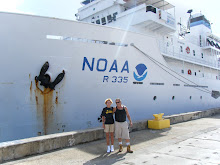Thursday, February 11, 2010
We're off!
With great anticipation (at least on my part) we departed Guam at 11:30 A.M. Thursday. The scientists have great expectations and most of them matched my excitement. The ship's crew is mellow - they sail all the time. We went about a mile off shore and spent a few hours while scientists calibrated their equipment. We then went back into Apra Harbor so the multibeam sonar could be calibrated. During the night we actually set sail and are now at Galvez Banks, our first study site. The scientists are continuing their work with the sonar. This will probably take all day today and maybe part of tomorrow. We need the sonar to get good maps of the seafloor so the fish experts can place their gear in the best spots to find fish. We have at least four ways to survey the fish: acoustically, with an AUV (autonomous underwater vehicle), with a towed camera and several rigs that have 2 cameras each and use bait to attract fish. I will share more when the equipment is being used.
Subscribe to:
Post Comments (Atom)



2 comments:
Hey, Ms. Tatreau! How is your trip going so far? I know it was only a day on the boat, but I was curious. Also, have you reached your destination already?
StingRay-5
Hi Sting,
This trip could not be better. Well, maybe if the seas were calm, but I’m not seasick and I’m learning a lot. The science crew is really helpful and the ship’s crew super friendly. I’m traveling with a great group of people.
Hi Ms. Tatreau,
Glad to hear that you're having fun. How many people are on the boat? Can you guys go fishing on the trip? By the way, the first recycle without you was not so good, but we were able to handle it. There were less than ten people signed up, so it took awhile.
Ritzmar-5
Hi Ritz
There are 41 people onboard. Twenty-two of us are the science team. That leaves 19 in the ship’s crew. I have included a page called Meet the Science Team. I hope to get everyone on before the end of the cruise. I’ll try for a Meet the Ship’s Crew too. Whenever possible someone is fishing and the menu last night included mahi mahi.
Post a Comment